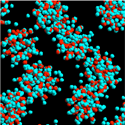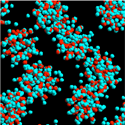Simulating nuclear pasta
In the collapsing core of a supernova, nuclei get squeezed together so tightly that they lose their individual identities and merge into a giant mass of nucleons. But according to theories going back almost 40 years, at slightly lower densities the nuclei will connect up to form what are called “pasta” phases—rods (“spaghetti”), flat slabs (“lasagna”), and even volumes of nucleons with spherical or rod-shaped voids (“cheese” and “anti-spaghetti”).
To see if these phases can really form in a supernova, Gentaro Watanabe of RIKEN at Wako in Japan and Hidetaka Sonoda of the University of Tokyo, along with colleagues from those and other Japanese institutions, have performed ab initio simulations of nuclei being squeezed toward the conditions of the pasta phases, as they report in Physical Review Letters.
They find that straight rods form once the density of the nuclei reaches about 30% that of a nucleus, but the formation process is surprising. As the initially spherical nuclei are squeezed, they begin to stick together in pairs at right angles to one another, forming a giant herringbone pattern, quite different from the parallel connections that were expected. As the density increases, the pairs fuse into “zig-zag” rods, which eventually straighten out.
Watanabe et al. explain that the nuclei initially link up because of the strong-force attraction between nucleons in neighboring nuclei. This picture contradicts the conventional view that the connections result from the so-called fission instability, which can cause a nucleus to deform into an ellipsoid that would touch and ultimately join with its neighbors. There is evidence that pasta phases should have large effects on neutrino transport, which is a major focus of supernova research, so Watanabe et al. recommend incorporating nuclear pasta into future supernova simulations. – David Ehrenstein





